Israel and the U.S. Launch GHF Fund to Replace the UN, but Its Disruptions Are Costing Civilian Lives
On May 27, a new Humanitarian Fund (GHF) began operating in Gaza—an Israeli-American initiative designed to replace the UN agencies that had previously overseen aid distribution in the enclave. Israeli authorities argue that the former mechanisms were compromised, claiming that humanitarian shipments were routinely intercepted by Hamas and used as leverage against the local population.
According to U.S. Ambassador to Israel Mike Huckabee, GHF is backed by a group of anonymous donors. The fund itself announced that its first contribution—$100 million—came from an unnamed foreign government. Israeli media have reported that the Israeli government contributed roughly $300 million to the fund, though no official confirmation has been issued. On June 26, the U.S. State Department announced a $30 million allocation to GHF and called on other countries to support the initiative.
Even before the first distribution center opened in Gaza, international organizations raised doubts about the model’s effectiveness. As The New York Times reported, citing UN officials, civilians must travel long distances and pass through Israeli military positions to access aid—conditions that in themselves pose a threat to life.
The UN expressed concern that Israel is effectively forcing Gaza residents to concentrate in specific locations—actions that, under international law, may constitute forcible population transfer. These concerns intensified after GHF’s first director, Jake Wood, resigned, stating that it was "impossible to implement the fund’s operations in strict accordance with the principles of humanity, neutrality, and independence." He was replaced by evangelical pastor and former Trump adviser Johnny Moore.
As of now, four GHF aid distribution sites are operating in Gaza. Three are located in the southern part of the enclave—along the so-called Morag route—and one in the center, near what is known as the Netzarim corridor. None have been established in the north. Meanwhile, a representative of the UN Office for the Coordination of Humanitarian Affairs (OCHA) estimates that up to one million people may remain in the northern part of the strip, including Gaza City. The distribution sites are guarded by a private American security firm.
The operating hours of GHF distribution points are highly unpredictable—they may open for just a few minutes before closing again. Because of this, and due to severe security risks, even residents who live nearby and could theoretically reach the sites often forgo the aid.
"The centers open for literally ten minutes," said Ilham, a local resident. "Thousands of starving people rush in. There’s not enough food, and then the crowd is dispersed by gunfire. Who’s shooting? When my husband and brother went there, people were being fired on with a cannon or a tank. Does Hamas or some gang have cannons and tanks?"
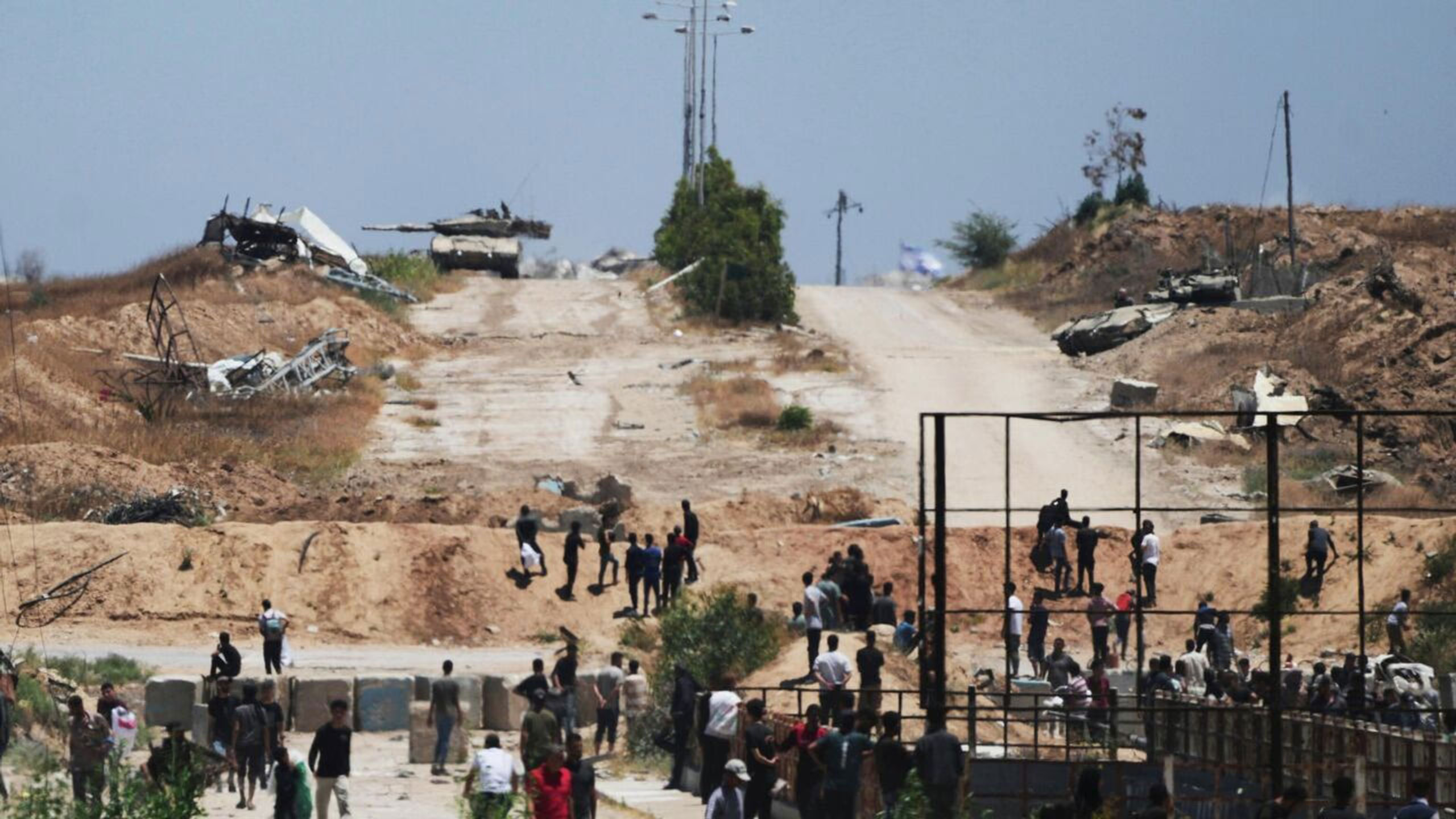
IDF tank near a humanitarian aid distribution center in Khan Younis.
The nearest humanitarian aid distribution point is five kilometers from Ilham’s home, but as she puts it, distance is not the main issue. Her husband went there to get food and barely made it back alive. A few days later, her brother and his sons tried to reach the center—but the shooting started even closer this time, and they were forced to leave empty-handed.
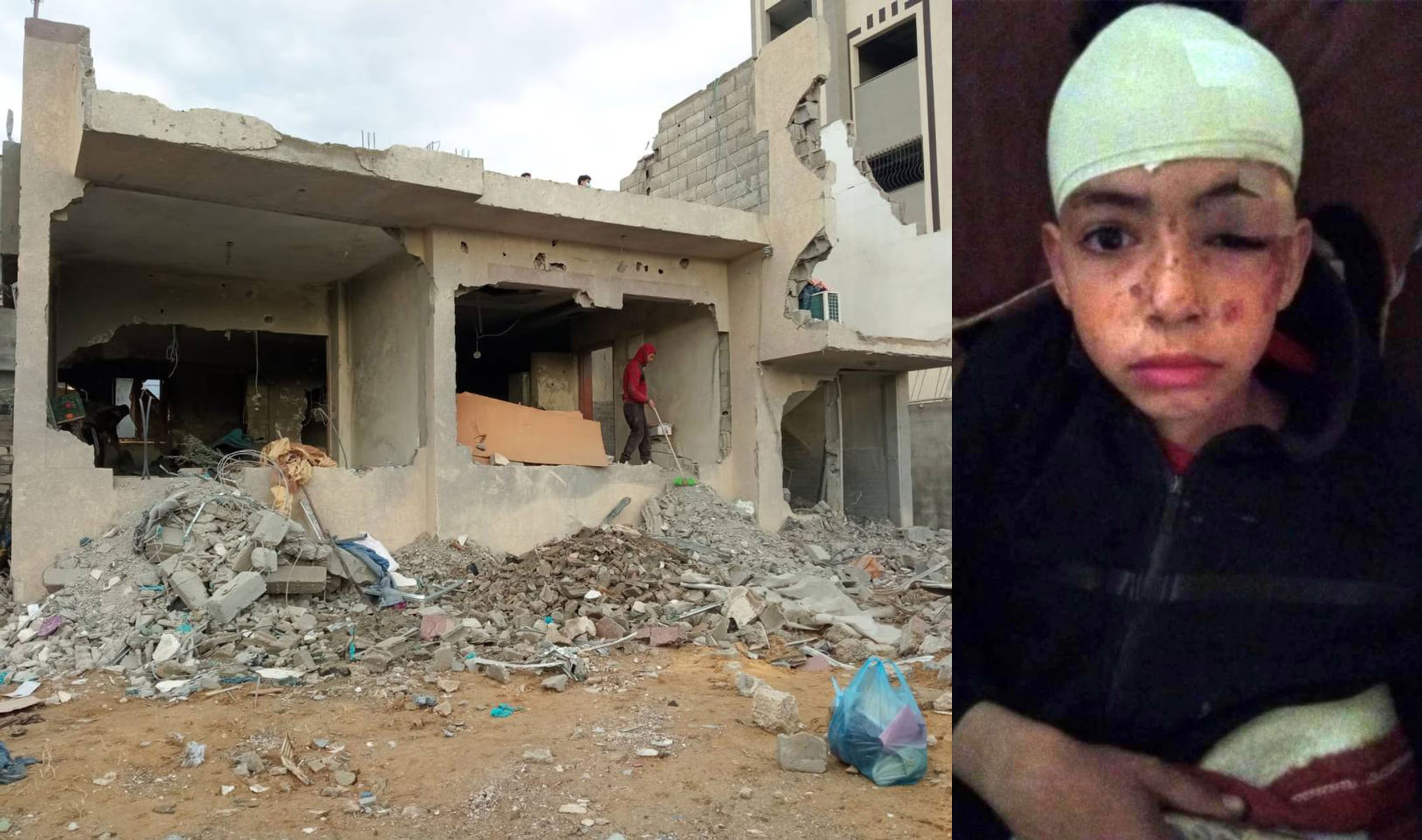
Ilham’s home in Nuseirat after the bombing, and her 10-year-old son who was pulled from the rubble.
According to the Israeli office of the International Committee of the Red Cross, since the launch of the GHF on May 27, there have been 19 mass-casualty incidents reported at the Red Cross field hospital in Rafah alone. In every case, the wounded said they had been injured either near GHF distribution centers or on the way to them. A total of 1,900 people were admitted, with at least 114 confirmed dead. All suffered gunshot or shrapnel wounds. The organization notes that the field hospital receives only a portion of the wounded—most are taken to Nasser Hospital in Khan Younis.
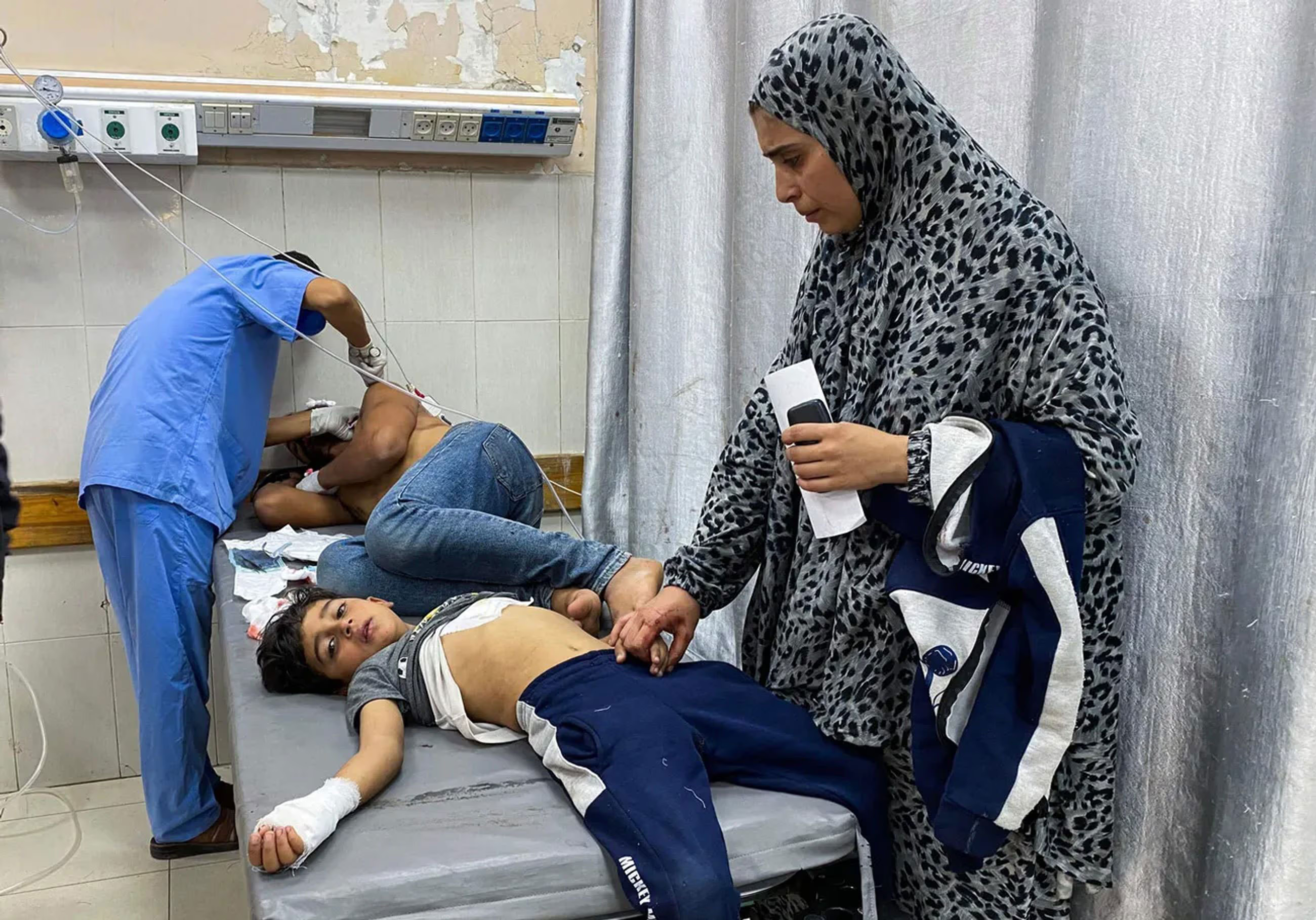
The wounded at Nasser Hospital in Khan Younis. June 3, 2025.
According to London-based surgeon Victoria Rose, who worked at Nasser Hospital until early June as part of a humanitarian mission, patients with gunshot wounds were rare until the end of May. Then their numbers spiked. Hundreds of wounded reported being shot near aid distribution points—and claimed the shooters were GHF security personnel.
Gaza’s Health Ministry, which is controlled by Hamas, states that more than 500 people have been killed in shootings near GHF centers since May 27.
GHF itself claims that "not a single death has been recorded in the immediate vicinity of its distribution sites." However, in a BBC interview on June 27, the fund’s director Johnny Moore stated: "I have never denied that people have died near humanitarian aid centers."
Might Over Right
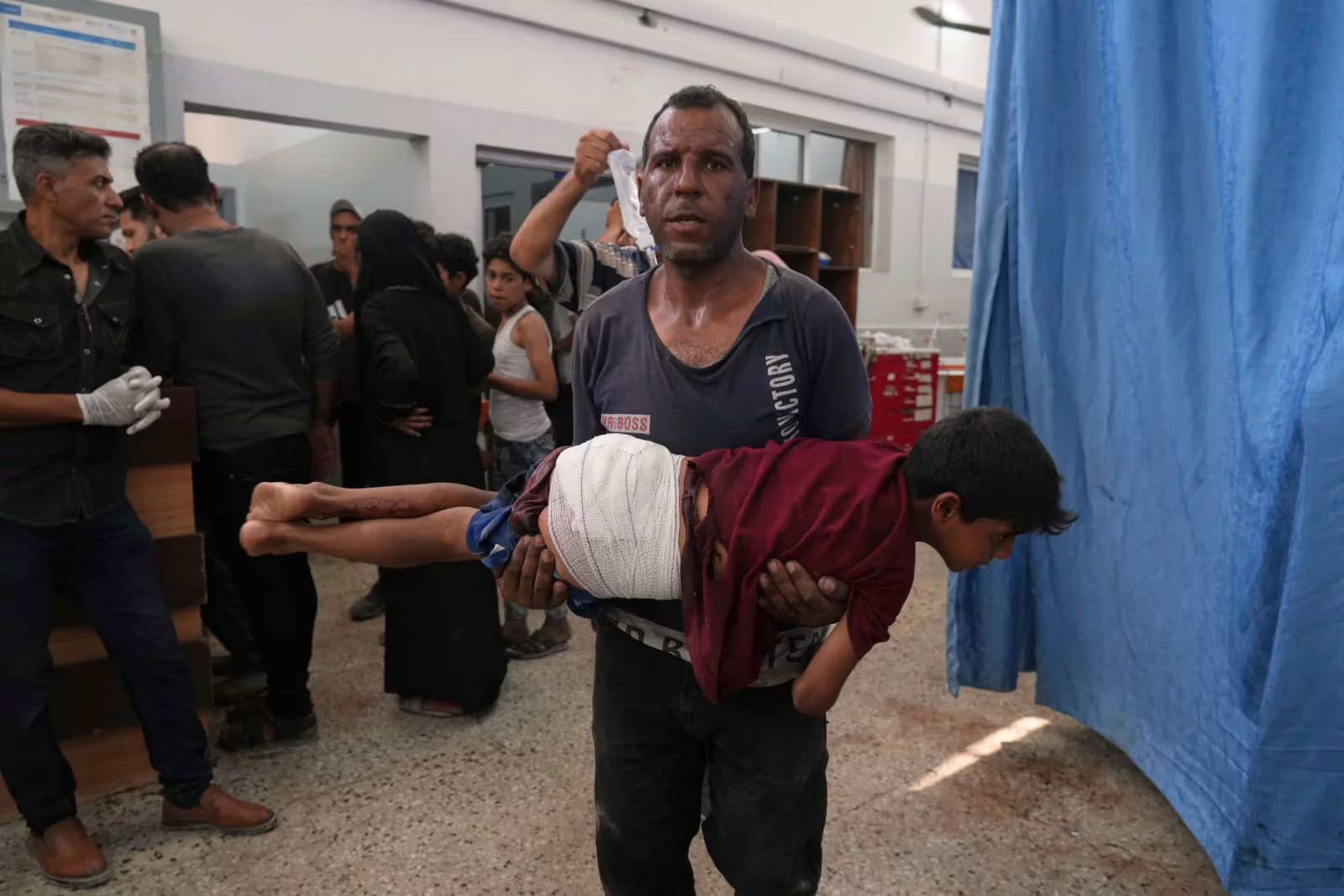
Israel Intensifies Strikes on Gaza
At Least 74 People Were Killed in 24 Hours, Including in Attacks on Aid Distribution Points and an Airstrike on a Café

Israeli Strike on Gaza School Kills 33—Army Says Militants Were Hiding in the Building

Israeli Strikes on a School Sheltering Displaced Families in Gaza Kill at Least 56, Three More Shot Dead in the Enclave’s Center While Waiting for UN Aid
This Happens Almost Every Day
Israeli Army, Hamas, and Armed Groups Exchange Fire Near Aid Points—Responsibility Remains Unclear
The question of who bears responsibility for the shootings near humanitarian aid centers in Gaza remains the subject of sharp dispute. Officially, the perimeter around distribution points is controlled by the Israel Defense Forces (IDF), but Israeli troops have repeatedly come under attack from Hamas militants in the same areas. According to official reports, some soldiers have been wounded in these incidents.
Reporters from the Israeli newspaper Haaretz spoke with soldiers stationed near GHF sites. Speaking on condition of anonymity, they said that gunfire is sometimes used to disperse crowds when situations become unmanageable. According to them, the intent is not to strike targets but to act "for safety." In an official statement, the IDF’s press office said: "The IDF prohibits attacking civilian populations."
The army added that in light of reports of civilian casualties near humanitarian aid distribution centers, the incidents are "being investigated by the relevant bodies within the Israel Defense Forces."
A few days after the Haaretz report was published, the Israeli military acknowledged that in some instances, civilians may indeed have been killed as a result of "inaccurate and ill-considered" artillery fire.
Earlier, responding to accusations, the IDF released a recording of a phone call with a Palestinian man who claimed that Hamas had opened fire on the crowd. However, the authenticity of the recording and the credibility of the speaker’s account could not be verified.
In addition to Hamas and the IDF, other armed groups have grown more active in Gaza since the war began. Militias not directly linked to either Hamas or the official Palestinian Authority have gained significant ground. One of the most prominent among them is the "Popular Forces"—a militia of roughly 400 fighters operating mainly in the Rafah area.
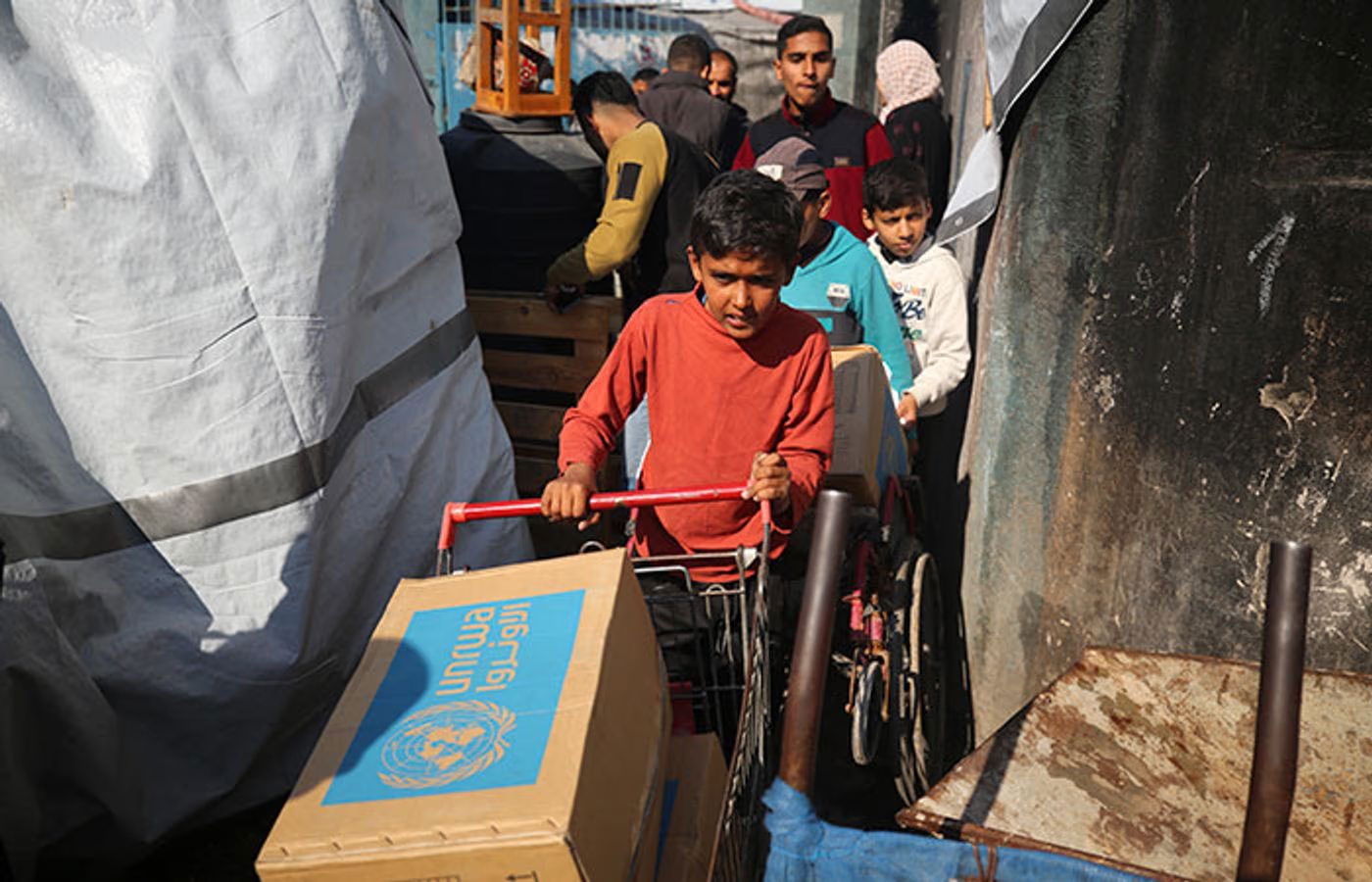
The group is led by Yasir Abu Shabab, a Bedouin who was previously convicted of drug trafficking and imprisoned by Hamas. After Israeli airstrikes destroyed several prison facilities, Abu Shabab was released and went on to form his own militia. Since then, the "Popular Forces" have claimed they are fighting Hamas remnants and helping to distribute humanitarian aid.
Allegations of Israeli support for the group first surfaced after a statement by former Defense Minister Avigdor Lieberman. The prime minister’s office did not deny the claim, saying only that "Israel is taking various steps to dismantle Hamas, based on recommendations from all national security agencies."
Abu Shabab later claimed to be operating under the authority of the Palestinian Authority in Ramallah, though officials there have not formally confirmed this. In late May, UN humanitarian coordinator for Gaza and the West Bank Jonathan Whittall told The Guardian that Abu Shabab’s fighters were responsible for repeated looting of aid shipments arriving through the Kerem Shalom crossing.
Gaza residents say the "Popular Forces" are just one of several groups controlling resource distribution in devastated areas. According to them, a significant portion of food and other goods intended for GHF centers is either intercepted before it arrives or forcibly taken from civilians at gunpoint—only to reappear on the black market.
Northern Gaza Is Cut Off: Residents Starve, Hospitals Lack Medicine, and Aid Is Blocked by Destruction and Sieges
In Nuseirat, as in most parts of Gaza, basic food staples remain out of reach for the majority of residents. Ilham says her family hasn’t eaten vegetables, fruit, or meat in months. The only food they can afford is a bit of lentils or rice, bought on the black market. They cook over open flames—there’s no gas, firewood is expensive, the furniture has long been chopped up for kindling, and they now burn plastic despite the choking fumes. They eat once a day. "We’re always hungry, but we have no choice," she says.
A severe shortage of drinking water is making the situation worse. Water is hauled in buckets from wells, which require navigating rubble-strewn streets. In some areas, Ilham says, groups are trying to maintain order, but she isn’t sure whether they are affiliated with Hamas.
"Hearing your children ask for food and not being able to give them any—it’s torture," she says. "But the aid centers—it’s like something out of The Hunger Games. People go there not knowing if they’ll come back alive. And yet the hunger is so intense, they’re willing to risk it."
GHF aid is reaching almost none of northern Gaza, including Gaza City. According to international organizations, up to one million people may still be in that area. Yet there are no distribution points north of the Netzarim corridor. The office of COGAT, formerly responsible for coordinating humanitarian relief, stated that authority has now been transferred to the Ministry of Defense, the Ministry of Foreign Affairs, and the Israeli Prime Minister’s Office.
Gaza residents are forced to evacuate repeatedly. According to Mohammad, his family has left and returned to their home at least four times. "You grab a bit of clothing, a couple of books, some water. Even if you can carry everything yourself—there are elderly people, there are children, you need transportation. But there are no vehicles: the ones that survived are out of fuel or controlled by armed groups. A donkey and cart cost $200. We don’t have that kind of money. And we don’t have the strength anymore—especially when even the so-called safe zones are being bombed."
Mohammad’s typical day begins at 5 a.m. searching for something to burn. Gas hasn’t been available for months, and the only way to light a fire is to burn leftover plastic. After that comes a cup of unsweetened tea and hours spent waiting in line for water. Then, a trip to the market for food. "Yesterday, I couldn’t buy anything. If you’re lucky, there’s flour and canned goods. We haven’t seen fruits or vegetables in a year and a half."
He visits his younger brother in the hospital—paralyzed by a piece of shrapnel. In the same attack, his nephew was killed on the way home from relatives, carrying a bag of flour. "In the evenings, we just sit and wait for the next round of shelling."
Mohammad says he never believed the U.S. plan to resettle Gazans in other countries would actually happen. But now, he says, he doesn’t know a single person who wouldn’t leave if given the chance.
"Israel has done everything to make life here impossible. These constant bombings aren’t about fighting Hamas—they’re about exterminating civilians," says Mohammad, a Gaza resident. According to him, Hamas has largely been dismantled, yet the attacks continue. "Do you really think Hamas is still here? Israel and Hamas are barely different. We’re being killed by religious fanatics on both sides." He estimates tens of thousands killed, hundreds of thousands wounded—and wonders if those responsible will ever be forgiven. "If you don’t care about our children, at least think about your own future."
Even the humanitarian aid that Israel permits into the Strip is not meeting the needs. Olga Cherevko, a representative of the UN Office for the Coordination of Humanitarian Affairs (OCHA) in Gaza, said current aid volumes are a fraction of what entered during ceasefires. According to her, the food delivered over three weeks now used to arrive in just one day. These figures are also confirmed by the office of Israel’s Coordinator of Government Activities in the Territories.
"It can take a full day or more just to deliver a single shipment," says Cherevko. "We wait for IDF permits, roads are destroyed, trucks break down. I once had to wait eight hours to collect goods at the border. And 90% of our requests are denied." The biggest change, she says, is in distribution. Where the UN once operated 400 distribution centers across Gaza, now, according to Cherevko, the IDF only allows deliveries to bakeries and kitchens. "People have to travel miles to receive help. And there’s not enough for everyone."
Might Over Right

Heavy Bombardment Follows Calls for Peace
Israel Strikes Gaza as Trump’s Team Pushes a New Ceasefire Plan

Israel Keeps Gaza Under Total Blockade, Cutting Two Million People Off From Food, Water, and Medicine
This Is Not a Humanitarian Crisis—It’s a Deliberate Siege

Blockade and Economic Devastation Leave Gaza Without Food
Families Survive on Canned Goods and Aid
Additional complications arose after the closure of the Zikim crossing, which had handled a significant portion of humanitarian aid. The Israeli government has not specified when it might reopen.
The food shortage is so severe that aid is being seized directly from the trucks. "I saw elderly people, women, and children rushing at the vehicles," says Cherevko. "One woman in the final stages of pregnancy literally jumped onto a truck to grab a sack of flour."
According to Cherevko, the key problem is the lack of fuel, which is essential for water purification and hospital operations. OCHA reports that only 40% of water infrastructure is currently functioning. Without fuel, treatment plants will shut down.
Requests for fuel deliveries were submitted to Israeli authorities as early as April, when the situation became critical. A few shipments were approved but then blocked again. The consequences, she warns, could be catastrophic.
Even with limited medical supplies resupplied, the situation in hospitals remains dire. Surgeon Victoria Rose, who worked at Nasser Hospital in May, described her third visit as "the hardest since the war began." "Sixty percent of patients were children. I performed up to ten surgeries a day, sometimes more. Every workday started with infants—first the one-year-olds, then the older children. Most were between six and eleven. Nearly all had blast injuries, amputations, or burns."
There is a shortage of antibiotics, saline solutions, and antiseptics. At one point, Rose says, surgical instruments were sterilized with vinegar. "We ran out of painkillers. Children lay in post-op screaming in pain. There was nothing I could do for them."
